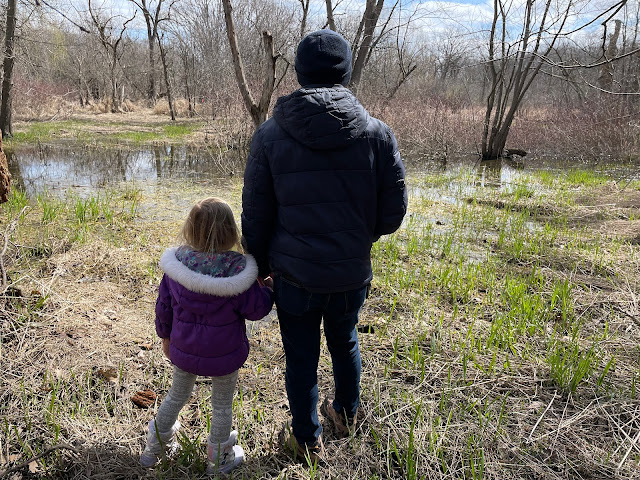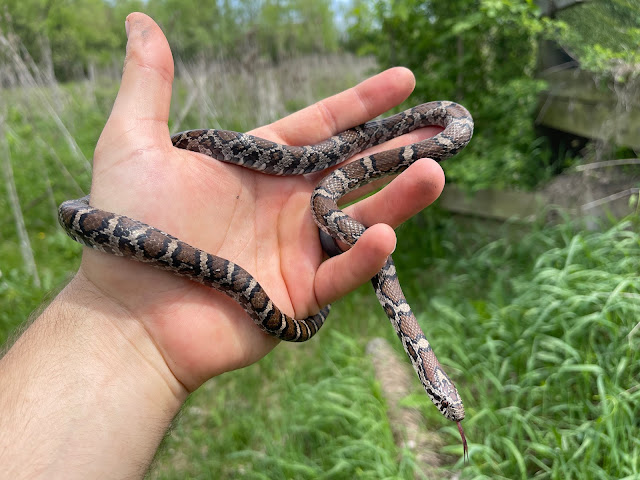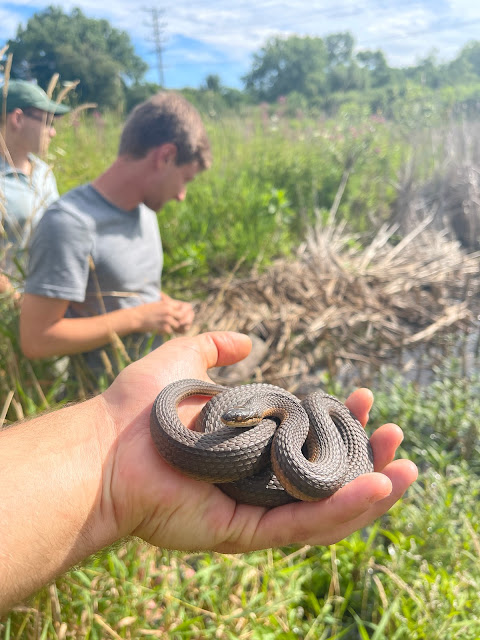In early March, Matt and I headed down to Vermilion County. Matt wanted to see some salamanders and my goal was to watch wood frogs (Rana sylvatica) call (it's been awhile). Winters in the Chicago area are tough, and usually by February, people like me (and Matt) are so freakin' fed up with cabin fever that we will do just about anything to experience a wild herp and its habitat. At this time, the Chicago area was behind central IL by at least a couple of weeks.
A vernal pool used by Ambystoma platineum, the hybrid species commonly known as the silvery salamander.
This one was found under a log in the vicinity and photographed very briefly before being returned to its home.
Middle Fork of the Vermilion River. It was very cold; that didn't stop Matt's son Alan from rolling up his pant legs and dip-netting for fish.
We found this southern two-lined salamander (Eurycea cirrigera) in what looked like a fen or otherwise some sort of seep-fed wetland. I had only ever found them in shallow wooded seeps or rocky streams in Will and Kankakee Counties. Earlier in the day we did find a few adult and larval cirrigera along a stream near the platineum site.
Hiking along, we discovered a number of four-toed salamanders (Hemidactylium scutatum) underneath logs. We were looking for Ambystomatids and did not expect to see these, let alone hundreds. It was a nice surprise.
One of many redback salamanders (Plethodon cinereus), and I believe all were of the "leadback" variety.
Later in March, Lumen and I searched this marsh near Elgin for signs of salamander reproductive activity. Nothing, but still a fun time.
At West DuPage Woods in West Chicago, a nice place near home.
Over the last decade or so, I've become a big fan of spring ephemerals. This is Dutchman's breeches (Dicentra cucullaria) in a wooded preserve near Yorkville.
Mid-April also produces smooth green snakes (Opheodrys vernalis) under the right conditions, and in only a few places.
A marsh at West Branch Forest Preserve. I live across the street from here and not a day goes by where I'm not consciously thankful for the privilege. I was out scouting for grey treefrogs (Hyla versicolor). I last heard a couple of frogs calling in 2018, but 2022 produced approximately 8-12 individuals calling. Locally, this is one of the more exciting projects.
May is the best time to find milksnakes (Lampropeltis triangulum) where they occur in the area. This little neonate born last fall provided Lumen with her first snake bite (it was bound to happen eventually). As you can see, she is terrified.
Here is Lumen with a chunky tiger salamander (Ambystoma tigrinum) we found under an old discarded board.
An adult milksnake at the same site.
One night shortly afterward, it rained really hard and Matt texted me telling me that they had passed a roadside ditch near Elgin full of calling frogs. I headed out and was treated to quite a frog orgy - grey treefrogs, chorus frogs (Pseudacris borealis), and toads (Anaxyrus americanus) calling their little hearts out. Lots of eggs masses too.
One of the grey treefrogs
As part of the bigger project I'm working on, I needed to beef up my familiarity with the lizards of the region. In 2020 and 2021 I was nearly obsessed with five-lined skinks (Plestiodon fasciatus). If we're being honest, I still think about them a lot, but my obsession has been tempered by the fact that I've pretty much wrapped up what I was working on, skink-wise - even though I'm all ears when it comes to new information.
Toward the end of May, I sought a Cook County racerunner (Aspidoscelis sexlineatus) but instead we found lots of skinks. I documented each one -well, each we were able to catch. They are fast little buggers.
This is prime skink habitat in Cook County (Matt and Alan pictured).
Here is an adult skink.
Matt examining the first skink we caught.
Me with a skink I found underneath this piece of discarded trash.
I took the family on a trip to Maquoketa Caves State Park in Iowa in June, where Lumen found this grey treefrog.
2021 was a horrible year for amphibians. Prolonged drought really put a dent in observations and probably in actual numbers. I think I may have seen two toads in my yard all year. 2022 was a far better year! Toads and other anurans throughout the summer and into early fall after every refreshing rain event.
Here is just one of the many toads who filled their rotund bellies at night underneath the porch light.
In the heat of midsummer, we guide ourselves toward water. And we've been visiting this site near our home for a few years now, cooling off in the river and enjoying all of its aquatic life.
Queensnake (Regina septemvittata)
Crayfish
A female painted turtle (Chryemys picta) on her way to lay eggs at the Grove in early July.
A few big mulberry trees grace a park in town and I drove over there late one morning in mid-July to pick some. I was surprised to spot this adult fox snake (Pantherophis vulpinus) there, stalking birds also attracted to the tree for its berries. I usually only see this species on the ground but I know they do climb - they certainly are built for it. On a side note, it was nice to pick and eat the mulberries here (not a forest preserve). A couple of years ago, I was scolded by a DuPage County forest preserve law enforcement official for picking and eating mulberries - an invasive species, mind you - along a roadside while I was with my daughter. All he could say was, "No collecting". I respectfully explained what these were and again, "...no collecting". Rules are rules, I get that. I just think there ought to be some flexibility. We are constantly encouraged to do things that are good for the earth - grow native plants, discover the nature around us. But our laws are outdated and many of the people enforcing them are of a different mindset. You can still be ticketed for fostering your own little prairie because the grass is longer than what the municipality allows. Can we get with the times already?
Ok, sorry. Onward.
Churchill Prairie, a beautiful and precious remnant, right here in DuPage County.
Back in 2020, a Graham's crayfish snake (Regina grahamii) was discovered in DuPage County for the first time in a quarter century (we wrote that one up for the Bulletin of the Chicago Herpetological Society). Following the dry lull that was 2021, we were exceptionally elated to discover not one but an additional TWO crayfish snakes. The first was a young male I found on July 23rd, after a night of heavy rain. The second was a gravid female found four days later. It is so great to see this species doing well at at least one site.
Nathan with the male found on the 23rd.
Early August saw up visiting Door County for the first time since 2015 (there's a post from that trip here in the archives). We always talked about taking one more trip with our dog Cassius and so this was it. He's getting up there in years - he turns eleven this March. And though he is healthy, it was clear to us that he just isn't cut out for these types of trips anymore. But we did have a good time.
Here is one of a few metamorph wood frogs we found while hiking White Cedar Forest Natural Area.
From Washington Island
Lumen hopped aboard the fox snake train with her first ever in late August.
Again, the frogs were out in full force, especially later in the summer.
We traveled east for a wedding but we enjoyed so much of what the area had to offer in terms of natural areas. I hoped to find copperheads (Agkistrodon contortrix) at Sleeping Giant State Park in Connecticut, and it sure looked like I would. But they were not on the menu that day, just a handful of viciously defensive eastern garter snakes (Thamnophis sirtalis).
Does this not look copperheady?
Garter
Back home, more frogs in the yard.
A high-contrast chorus frog.
A nice northern leopard frog (Rana pipiens)
And a green frog (Rana clamitans) with a foot fetish.
Nathan graciously invited me up to the Midwest Partners in Amphibian and Reptile Conservation (PARC) meeting in Grand Rapids to see the poster he put together which distills all of the queensnake data we collected throughout 2019 and 2020. In some ways the meeting was nerve-wracking because not only was I the only non-herpetologist (or herpetology student) present but I'm also pretty introverted. But I met some really nice people including a few I was well familiar with otherwise.
In October I headed down to southern Illinois for a few days. I actually had an agenda, but the area had not seen measurable rainfall in months and it was bone-dry. The trip produced fewer herps than the previous worst trip, but unlike that trip (which was cold and rainy), it was warm and sunny and I got to do a lot of hiking and exploring. Here is a scene from Garden of the Gods.
A cottonmouth (Agkistrodon piscivorus) heading toward the bluffs.
A timber rattlesnake (Crotalus horridus) taking a crack at this crack in the sandstone wall.
More to come in '23!




























.jpg)





.jpg)






.jpg)